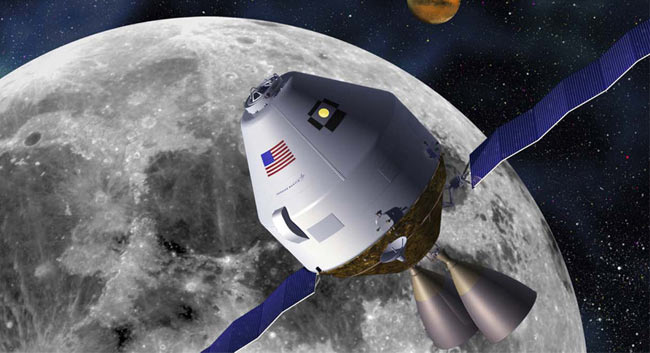NASA Expected To Choose CEV Contractor by Fall 2006

With Crew Exploration Vehicle (CEV) proposals finally inhand, NASA is expected to decide by early fall whether it will be LockheedMartin or the team of Northrop Grumman and Boeing that helps the U.S. spaceagency design and build the key element of its next human space transportationsystem.
The Lockheed Martin and Northrop Grumman-Boeing teams havebeen under contract since July when NASA gave each team $28 million to help refinetheir respective CEV concepts. A follow-up solicitation was issued in Januaryand both teams submitted their final proposals to NASA by the March 20deadline.
NASA has not said how much it expects the CEV to cost, butthe agency has included over $20 billion in its latest five-year budget forConstellation Systems, the program that encompasses development of the CEV, twonew launch vehicles and other hardware NASA needs to return to the Moon by2020.
Jeffrey Hanley, manager of NASA's Constellation Program,said the agency expects to select a single CEV contractor team by early fall.
While Lockheed Martin has announcedpublicly where it would locate its CEV work force if it wins thecompetition, Northrop Grumman has provided its CEV work-force plan only toNASA.
Lockheed Martin announced inlate February that if it wins, it would do final assembly and checkout ofthe vehicle at Kennedy Space Center, bringing about 300 to 400 new jobs toFlorida.
The firm followed up its Florida announcement with a March24 announcementthat it would put about 1,200 mostly engineering jobs in Houston in order to beclose to Johnson Space Center, the NASA center running the CEV program. JohnKaras, Lockheed Martin's vice president of space exploration, said in an interviewprior to the announcement that a CEV win would mean about 300 to 400 new jobsat the company's facilities in Denver.
Breaking space news, the latest updates on rocket launches, skywatching events and more!
CEV evolution
Since giving the two teams Phase 1 contracts last summer to helprefine their CEV concepts, NASA has decreed that the CEV will be a ballisticentry capsule that NASA Administrator Mike Griffin has dubbed "Apollo on steroids."
NASA also has established that the CEV will be launched atopa taller, more powerful version of the solid-rocket booster that helps launchthe space shuttle. NASA hopes to start flight testing the CEV and its launcheraround the end of the decade and to put the new system in service no later than2014.
When Griffin took office last year, he was determined toaccelerate the development of CEV in order to field the new system as close tothe space shuttle's planned 2010 retirement as possible. Budget realities,however, have since forced Griffin to ease back on the throttle.
While the budget for Constellation Systems - the programthat encompasses development of the CEV, two new launch vehicles and relatedsystems - would jump 76 percent to $3 billion under NASA's 2007 spendingrequest and continue to grow through the end of the decade, NASA says itprobably cannot afford to field the CEV and its shuttle-derived launcher in2012 as previously forecast. NASA is back to shooting for 2014, the originaldate President George W. Bush set in his landmark Vision for Space Explorationspeech at NASA headquarters here in January 2004.
Other efforts
While the CEV competition is the highest profile part ofNASA's effort to field its first new human transportation system since thespace shuttle, it is not the only part.
Design of the Crew Launch Vehicle (CLV) is under way atNASA's Marshall Space Flight Center in Huntsville, Ala. NASA early this yearselected ATK Thiokol to help develop the Crew Launch Vehicle's first stage,which will be based on the space shuttle solid-rocket boosters the Promontory,Utah-based company has been building for the past quarter century.
Thiokol spokesman George Torres said the company is"helping NASA design the CLV by doing analysis on the requirements tosupport adapting the [reusable solid-rocket motors] for the CLV firststage." A contract is expected later this year.
NASA also is preparing to go out with a solicitation for theCrew Launch Vehicle's upper stage. Marshall Space Flight Center issued arequest for information March 20 seeking input from industry meant to help theagency decide how to structure the CLV upper-stage acquisition. NASA plans topower the upper stage with an updated version of the J-2 engine originallydesigned for the Saturn 5, the workhorse of the Apollo program.
Commercial ISS flights
In parallel to the NASA-led CEV development, the agencyplans to spend $500 million over the next five years on a demonstration programmeant to coax into existence a low-cost alternative to the CEV for InternationalSpace Station resupply and crew rotation missions.
Proposals were due March 3. NASA is expected to announce itsselections in early June.
NASA spokeswoman Dolores Beasley said the agency receivedproposals "from a wide variety of organizations across the full spectrumof industry." While declining to say how many proposals NASA received, shesaid the agency was "pleased with industry's response" to the solicitation.
Sources following the Commercial OrbitalTransportation Services competition said NASA received about 20 proposals.These same sources said NASA plans to inform the field of competitors in earlyApril whether they made the short list for further consideration. Beasley wouldnot confirm that a preliminary down-select was under way, saying that internalmilestones and other such information is considered "competitionsensitive" and would not be released.
Brian Berger is the Editor-in-Chief of SpaceNews, a bi-weekly space industry news magazine, and SpaceNews.com. He joined SpaceNews covering NASA in 1998 and was named Senior Staff Writer in 2004 before becoming Deputy Editor in 2008. Brian's reporting on NASA's 2003 Columbia space shuttle accident and received the Communications Award from the National Space Club Huntsville Chapter in 2019. Brian received a bachelor's degree in magazine production and editing from Ohio University's E.W. Scripps School of Journalism.
